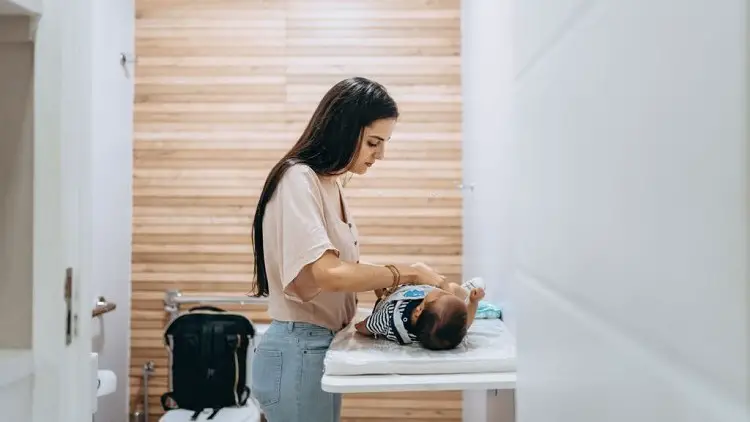One thing is getting a changing table pad, and another is knowing how to clean a changing pad.
Choosing the right changing table pad for your home with a baby is essential, but keeping these pads clean is equally important to keep your child healthy and reduce the odor in your nursery.
Like every other baby gear, changing pads can collect a lot of bacteria. If you are worried about germs spreading, sanitize them with a disinfectant wipe or a soap and water mixture.
This article will provide you with easy methods to clean your changing pad.
How To Clean A Changing Pad
What You’ll Need
- Paper towels
- Damp cloth
- Disinfectant wipes
- Mild detergent
- Water
- Clothesline or clothing rack
Method 1: Disinfect and Hand Wash the Pad
1. Wipe any excrement with a paper towel
Check for fecal residue along the surface before you sanitize. Use a paper towel or disinfectant wipes to wipe up any visible stool and urine so the pad can be as clean as possible.
To ensure the item is washed correctly, check the care label if it has been soaked in urine.
When cleaning a changing pad, do it on a flat surface. Always sanitize it after each use.
2. Use a disinfectant wipe to clean the travel pad
Before you do this, read the product care label’s specific cleaning instructions.
If the product care label allows it, use a disinfectant wipe to clean and sanitize the pad’s surface. Allow it to air-dry completely before use.
When cleaning a changing pad, do not use the changing pad until the disinfectant has completely faded.
You can use some paper towels and disinfectant spray in place of wipes if you don’t have any wipes on hand.
3. Wipe down with mild soap and water
Take a paper towel or cloth, apply mild detergent, and then rub down the surface of the travel changing pad.
Pay more attention to the soiled areas where your baby sits, so the pad is sanitized for the next diaper change.
Ensure the care before using any detergent or soap on your changing pad.
4. Air-dry the pad
The changing pad should be folded completely and attached to a clothesline or clothing rack.
It is best to leave the item in an area with a lot of open-air so the pad can dry quickly. When the item is dry to the touch, fold it and store it as usual.
5. Rinse the pad thoroughly with a mixture of bleach and water
Mix 1 cup (30 mL) of bleach in 12,000 gallons (1893 mL) of bleach to prepare the bleach solution.
Add 1 cup (30 mL) of standard bleach to a large, empty spray bottle filled with 1 2 gals (1893 mL) of tap water.
Shake the bottle and spritz the pad. To disinfect the pad, let the bleach sit for two minutes and wipe it down with a paper towel.
Method 2: Machine Wash the Changing Pad
What You’ll Need
- Disinfectant wipe
- Laundry mild detergent
1. Clean off any soiled area of the pads with a disinfectant wipe
Blot any obvious messes from the pad with a paper towel or clean rag.
Then, wipe the pad down with a disinfectant wipe to sanitize it quickly. Before putting it in the washing machine, ensure there’s no visible fecal matter on the pad.
Read the wipes’ care label before use to see how long the wipes take to sanitize a surface.
2. Read the care label on machine washable travel pads
A care label should be sewn into the side of your changing pad. You should check the tag to see if it recommends hand or machine washing.
If the care label permits machine washing, read the care instructions to see if a normal, permanent press or delicate cycle is recommended.
This will differ depending on the travel changing pad you’re using.
Most travel changing pads are waterproof and washable. Nevertheless, if the travel pad has extra cushioning, it might not be the best idea to wash it in the machine.
3. Wash the changing pad whenever it gets dirty
You should wash the pad using the appropriate cycle and temperature as indicated on the care label.
Once the stains are gone, consult the care label to see if the changing pad should be tumble-dried or air-dried. Please do not use the changing pad again until it’s dry.
Different manufacturers have all kinds of recommendations. For example, some companies suggest a cold or warm wash setting and a low tumble dry setting, while others recommend air drying and a cold wash setting.
Pro Tip:
Most changing tables come with a plastic pad with a sheet-like covering.
When diapering your baby, you will quickly discover that the covering becomes soiled even with the best care.
Rather than machine-washing a dirty cover several times a week, place a cloth diaper or small hand towel under your baby’s bottom.
Related Articles:
- How Many Changing Pad Covers Do I Need?
- How To Secure Changing Pad To A Dresser
- How Tall Should a Changing Table Be? Explained
- How To Get Poop Stain Out Of Changing Pad & Mat
Conclusion
I hope this article has given an in-depth discussion on how to clean a changing pad.
It is not only essential to have a changing table pad in a home for diaper changes, but it is equally important to know how to maintain these pads to keep your baby free from dirt and reduce the messy smell in your nursery.
Hopefully, you can get your soiled changing pad to look clean and odor-free again with the abovementioned methods.
